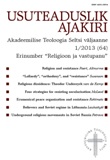Underground Hindu and Buddhist-inspired religious movements in Soviet Russia
Underground Hindu and Buddhist-inspired religious movements in Soviet Russia
Author(s): Maria PetrovaSubject(s): Christian Theology and Religion
Published by: Akadeemiline Teoloogia Selts
Keywords: Histroy of Religion
Summary/Abstract: The paper deals with the activities of the underground religious/ spiritual movements, whose teachings are largely influenced or contain the elements of Eastern (in particular, Indian) religions and philosophies, in the Soviet Russia. Special attention is paid to Buddhist and Hindu-inspired movements (the group of Bidiia Dandaron, ISKCON and yogic groups, Kunta Yoga adherents etc). Although the research mainly focuses on the period between the late 1950s and the late 1980s (characterized by the return to the active persecution of religion) it is also placed in the historical context of tsarist and especially Soviet governments’ policies towards the people, practicing Eastern religions. Ironically, the attempts of the Soviet authorities to impose a ban on all the manifestations of religiosity or at least to keep them all under control led to quite an opposite result. The members of the underground groups of that time mention that the ‘meaninglessness and suffocating monotony’ of their existence required some kind of compensation, which obviously could be found only in spiritual sphere. Thus, the situation which developed in the USSR in the above-mentioned period gave rise to a unique generation of spiritual seekers, whose protest against the lack of freedom and information developed into specific forms. It included both the individual/inner form, aimed at spiritual self-improvement and self-education, and collective/outer forms, such as joining religious groups, participation in seminars and lectures, publishing and spreading of the samizdat literature, copying and translating of western literature, occasional contacts with foreigners – fighters for human rights and other forms of underground dissident activity. The paper examines the particular explosion of interest in Asia and Eastern religions in the 1960– 1980, which could be explained by the desire to withdraw from the realities of the Soviet regime and to experience the exotic faraway ‘elsewhere’, but at the same time is part of the worldwide trend, which could be characterized by the deviation from traditional mainstream religions and an increase of attention towards unusual, sometimes even bizarre ideas and teachings.
Journal: Usuteaduslik Ajakiri
- Issue Year: 2013
- Issue No: 1 (63)
- Page Range: 99-115
- Page Count: 17
- Language: English

